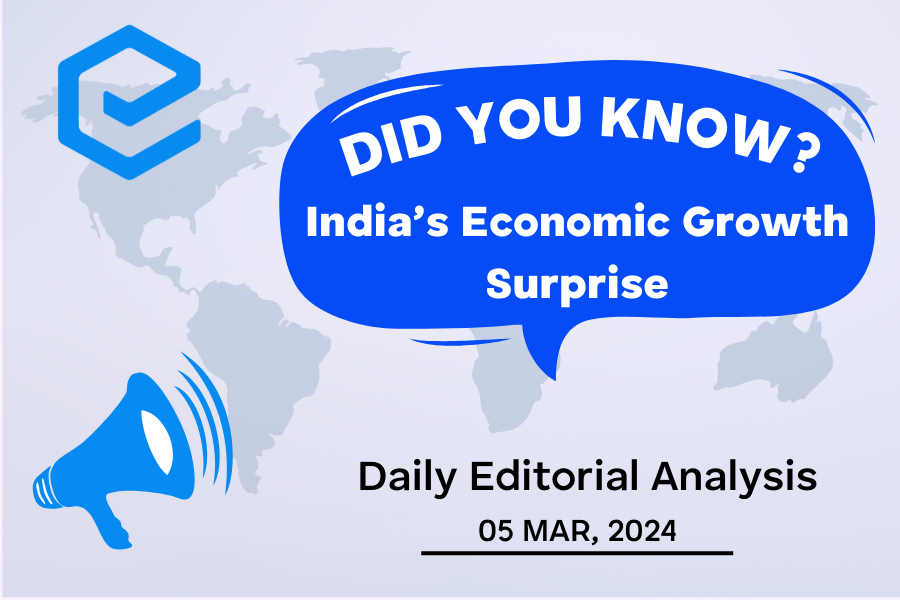
India’s recent economic growth has been nothing short of surprising, defying earlier projections and expectations. Despite facing numerous challenges, including the devastating effects of the COVID-19 pandemic and disruptions caused by policy changes, India has managed to maintain a steady growth trajectory. Several factors have contributed to this unexpected resilience, including robust domestic consumption, strong agricultural performance, and a surge in digitalization. However, sustaining this growth momentum will require continued reforms to address structural bottlenecks, enhance investment climate, and promote inclusive development across all sectors of the economy.
Tag: GS-3 Economy
Contents
In News:
India’s economic path has consistently exceeded expectations, as indicated by the National Statistical Office’s second advance estimate, which unveils a formidable GDP growth of 7.6%, surpassing initial projections.
Factors Contributing to India’s Growth Surprise
- Strengthening Economic Momentum
- Initial GDP estimate of 7.3% in January 2024.
- Second advance estimate surpasses expectations, indicating a robust economic momentum.
- Net taxes emerge as a significant contributor to overall growth.
- Rising Net Taxes and Subsidies
- Comparison of GDP growth (7.6%) with GVA growth (6.9% without net tax impact).
- Net taxes and subsidies play a crucial role in influencing economic performance.
- Average growth rate for the first three quarters stands at 8.2%.
- Effective Policy Measures: Robust Banking System and Corporate Balance Sheets
- Real GDP yet to fully recover to pre-pandemic levels.
- Strengthened bank and corporate balance sheets contribute to the effectiveness of policy initiatives.
- Domestic strengths and policy measures bring the economy closer to a 7% growth path.
Challenges and Anticipated Slowdown Analysis
- High Interest Rates
- Elevated interest rates pose challenges to sustained economic growth.
- Impact on borrowing, investment, consumer spending, and corporate expansion plans.
- Monetary policy constrained by inflation projections above RBI’s 4% target.
- Normalization of Net Tax Impact
- Notable contribution to GDP growth from rising net taxes in the current fiscal year.
- Expectation of net tax impact normalization in the coming year.
- Potential slowdown as the boost to economic growth from net taxes diminishes.
- Global Economic Conditions
- India’s economic performance linked to global market uncertainties.
- Trade tensions, geopolitical factors, and external shocks may influence the overall economic outlook.
- External factors beyond India’s control could impact economic prospects.
Private Consumption, Household Savings, and Changing Trends
- Growth Disparities – Rural vs. Urban
- Rural consumption trails urban consumption due to high food inflation impact.
- Agriculture grows at 0.7%, indicating a sluggish rural economy.
- Influence of Food Inflation
- High food inflation affects consumption patterns in both rural and urban areas.
- Nominal food consumption spending increases by 13%, reflecting inflationary pressure.
- Shifts in Consumption Patterns
- Household consumption transition towards non-food items over time.
- Rising per capita income influences changing consumer preferences.
- Need to adjust weightages in the consumer price index basket based on updated consumption patterns.
- Household Savings: Composition of National Savings
- Household savings constitute 61% of total savings but decline to 18.4% of GDP in 2022-23.
- Financial savings decrease to 5.3% of GDP, while physical savings increase.
- Reflects changing dynamics in the composition of national savings.
Analysis of Public, Corporate, and Household Investment Trends
- Private Corporate Investment Trends
- Stagnant trend in private corporate investments in fiscal year 2022-23.
- Concerns arise as private sector investments play a crucial role in economic growth.
- Public and Household Investments
- Significant growth in both public and household investments.
- Public investments influenced by government policies and infrastructure projects.
- Household investments indicate consumer confidence and economic stability.
Way Forward
- Reduce Policy Uncertainty
- Government’s role in reducing policy uncertainty and compliance costs is crucial.
- Stable and predictable policy environment needed for encouraging private sector investments.
- Broad-Based Revival of Private Investments
- Recognize the importance of a broad-based revival of private investments for sustained high growth rates.
- Focus on infrastructure and targeted schemes like PLI showing positive results.
- Comprehensive approach necessary to stimulate investments across various sectors.
Conclusion
- India’s surprising GDP growth necessitates a nuanced analysis of economic components.
- Attention to private corporate investments, consumption patterns, and savings dynamics crucial for sustained and inclusive economic growth.
- Government’s role in providing policy certainty and reducing compliance costs key for unlocking India’s economic potential.
Source: IE

